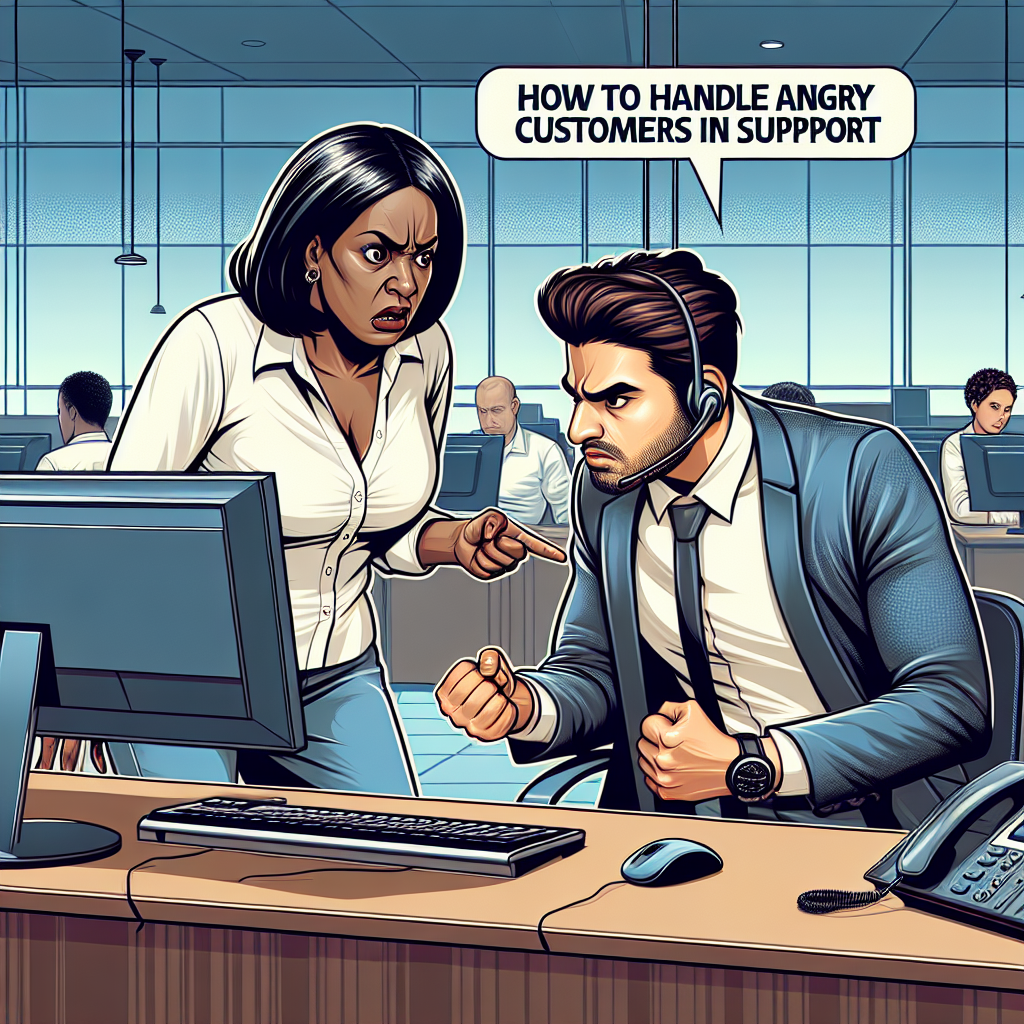In the fast-paced world of customer support, dealing with angry customers can be a challenging and stressful task. Whether they are upset about a product issue or dissatisfied with a service, it is crucial to handle their complaints with professionalism and empathy. In this guide, we will explore effective strategies for diffusing tense situations, actively listening to customer concerns, and finding solutions to their problems. By following these tips, you can turn a negative customer experience into a positive one, and build trust and loyalty with even the most irate individuals. So, let’s dive in and learn how to effectively handle angry customers in support!
Understanding the Psychology of Angry Customers

In the realm of customer support, it is imperative to delve into the intricate layers of the psychology of angry customers. By unraveling the underlying emotions that drive customer anger, support representatives can navigate turbulent situations with finesse and empathy.
Recognizing the emotions driving customer anger
-
Frustration: Customers often experience frustration when faced with obstacles or unresolved issues. This frustration can stem from various sources such as product malfunctions, miscommunication, or unmet expectations.
-
Disappointment: Anger in customers may also manifest as a result of disappointment. When their expectations are not met or when they feel let down by the service provided, disappointment can escalate into anger.
-
Feeling unheard: Another common emotion driving customer anger is the sense of not being heard or understood. Customers want to feel valued and respected, and when they perceive a lack of empathy or attention, it can lead to heightened frustration and anger.
Acknowledging the impact of unresolved issues on customer satisfaction
-
Diminished trust: Unresolved issues can significantly impact the level of trust a customer has in a company. When problems persist without resolution, customers may begin to question the reliability and credibility of the brand, leading to a decline in satisfaction and loyalty.
-
Negative word of mouth: Angry customers who have not had their issues addressed are more likely to share their negative experiences with others. This can tarnish the reputation of the company and deter potential customers from engaging with the brand.
-
Loss of repeat business: The failure to address and resolve customer issues in a timely manner can result in a loss of repeat business. Dissatisfied customers are unlikely to return for future purchases or services if their concerns have been disregarded or mishandled.

Effective Communication Strategies
Active Listening Techniques
When dealing with angry customers in a support role, mastering active listening techniques is crucial to diffusing tension and resolving issues effectively. Here are some essential strategies to employ:
-
Demonstrating empathy and understanding: One of the key components of active listening is showing genuine empathy towards the customer’s situation. By acknowledging their emotions and demonstrating understanding of their perspective, you can help the customer feel heard and valued. This can be achieved by using phrases such as “I understand how frustrating this must be for you” or “I appreciate you bringing this to our attention.”
-
Paraphrasing to show comprehension: Paraphrasing involves summarizing the customer’s concerns in your own words to confirm your understanding of the issue. This not only shows the customer that you are actively listening but also gives them the opportunity to clarify any misunderstandings. For example, you can say, “So if I understand correctly, you’re experiencing difficulties with X feature. Is that right?” This technique helps to ensure that both parties are on the same page and can work towards a resolution effectively.
Setting Clear Expectations
When dealing with angry customers in a support setting, setting clear expectations is crucial to managing their frustrations effectively. This involves establishing a transparent line of communication to ensure that customers know what to expect throughout the support process. Here are some key points to consider:
-
Managing customer expectations to avoid further frustration:
It is essential to be honest and transparent with customers about what can and cannot be achieved in resolving their issue. Avoid overpromising or making unrealistic commitments that may lead to disappointment later on. By setting realistic expectations from the start, customers are more likely to feel informed and less frustrated even if the resolution process takes time. -
Communicating realistic timelines for issue resolution:
Clearly communicate the expected timeline for resolving the customer’s problem, taking into account factors such as complexity, available resources, and any dependencies. Be upfront about any potential delays or setbacks that may occur and keep the customer updated on the progress. By providing a clear timeline, customers can better understand the process and feel more in control of the situation.
De-escalation Techniques
Remaining Calm and Professional
Maintaining composure in the face of customer frustration is crucial when dealing with angry customers in support situations. It is essential to remember that the customer is upset about an issue and not necessarily targeting you personally. By taking a deep breath and consciously maintaining a neutral tone, you can help diffuse the situation.
- Active Listening: Show the customer that you are actively listening to their concerns by nodding and providing verbal cues such as “I understand” or “I see.”
- Empathy: Express empathy by acknowledging the customer’s feelings and letting them know that you understand why they are upset.
- Avoiding Arguing: Refrain from engaging in arguments or becoming defensive. Instead, focus on finding a solution to the problem at hand.
- Offering Solutions: Provide options for resolving the issue and seek the customer’s input on how they would like to proceed.
- Setting Boundaries: Politely but firmly establish boundaries for acceptable behavior, ensuring that the customer understands that respect is a two-way street.
By remaining calm and professional, you can help navigate through the customer’s anger and work towards a resolution that satisfies both parties.
Offering Solutions, Not Excuses
When faced with an angry customer in a support situation, it is crucial to shift the focus from assigning blame to finding a viable solution. By emphasizing problem-solving over making excuses, support agents can effectively diffuse tension and work towards resolving the issue at hand. Here are some key points to remember when offering solutions to irate customers:
-
Focusing on problem-solving rather than placing blame: Instead of getting caught up in who or what caused the problem, support agents should concentrate on understanding the customer’s concerns and finding ways to address them. This approach helps to demonstrate empathy and a commitment to resolving the issue.
-
Providing options for resolution to regain customer trust: Offering customers a range of solutions to choose from can empower them and make them feel more in control of the situation. By presenting alternatives, support agents show a willingness to accommodate the customer’s needs and preferences, ultimately building trust and fostering a more positive interaction.
Implementing Customer-Centric Solutions
Empowering Support Agents
Empowering support agents is crucial in effectively handling angry customers in support. By equipping agents with the necessary tools and skills, they can confidently navigate challenging situations and provide exceptional customer service. Here are key strategies to empower support agents:
-
Providing training on conflict resolution and de-escalation: Offering comprehensive training programs that focus on de-escalation techniques, active listening, and empathy can help support agents effectively diffuse tense interactions with angry customers. By arming agents with the skills to navigate conflicts calmly and professionally, they can turn potentially negative experiences into positive outcomes.
-
Encouraging agents to take ownership of customer issues: Empowering support agents to take ownership of customer issues instills a sense of accountability and responsibility in resolving problems efficiently. By encouraging agents to see customer concerns through from start to finish, they can build rapport with customers, demonstrate dedication to finding solutions, and ultimately enhance the overall customer experience. This sense of ownership can also lead to quicker resolutions and increased customer satisfaction levels.
Seeking Feedback for Continuous Improvement
Collecting customer feedback is a crucial aspect of handling angry customers effectively in support. By actively seeking feedback, support teams can identify recurring pain points that lead to customer dissatisfaction. This process involves various strategies to gather insights from customers, such as:
-
Surveys: Sending out surveys after customer interactions to gauge satisfaction levels and gather specific feedback on areas for improvement.
-
Feedback Forms: Providing easily accessible feedback forms on the company’s website or within support communications to encourage customers to share their thoughts.
-
Social Media Monitoring: Monitoring social media channels for mentions, comments, or direct messages from customers expressing concerns or frustrations.
-
Analyzing Customer Interactions: Reviewing past interactions with angry customers to pinpoint common issues or triggers that lead to dissatisfaction.
Implementing changes based on customer suggestions is a proactive approach to address underlying problems and enhance the overall support experience. Support teams can leverage customer feedback to make data-driven decisions and implement customer-centric solutions, such as:
-
Training and Development: Providing additional training to support agents based on feedback received from customers to improve communication and conflict resolution skills.
-
Process Optimization: Streamlining support processes and procedures based on customer feedback to reduce response times and enhance efficiency.
-
Product or Service Enhancements: Collaborating with product or service teams to address recurring issues highlighted in customer feedback and make necessary improvements.

By continuously seeking feedback and implementing changes based on customer suggestions, support teams can demonstrate a commitment to customer satisfaction and drive positive outcomes in handling angry customers effectively.
Utilizing Technology for Enhanced Support
Implementing Chatbots for Initial Triage
In the realm of customer support, utilizing technology for enhanced efficiency is paramount. One effective method is implementing chatbots for initial triage to streamline the support process and cater to the needs of angry customers effectively.
-
Using AI-powered chatbots to address common customer queries: Chatbots equipped with artificial intelligence can swiftly handle common customer queries, such as order status inquiries or basic troubleshooting steps. By automating these routine tasks, chatbots free up human agents to focus on more complex issues that require personalized attention.
-
Escalating complex issues to human agents seamlessly: While chatbots excel at handling straightforward issues, they also play a crucial role in escalating complex problems to human agents seamlessly. By analyzing customer responses and behavior, chatbots can identify when a situation requires human intervention and smoothly transfer the interaction to a live agent. This ensures that angry customers receive the personalized assistance they need to resolve their issues satisfactorily.
Leveraging Customer Relationship Management (CRM) Systems
Customer Relationship Management (CRM) systems play a crucial role in effectively managing interactions with angry customers in support scenarios. These systems provide a centralized platform for storing and accessing valuable customer data, enabling support agents to tailor their responses and solutions to meet individual needs. Here are some key ways to leverage CRM systems for enhanced support:
-
Accessing customer history to personalize interactions: By utilizing CRM systems, support agents can easily review a customer’s past interactions, purchase history, and any previous issues they may have encountered. This insight allows agents to approach the current situation with a deeper understanding of the customer’s background, preferences, and potential pain points. Personalizing interactions based on this information can help defuse anger and build rapport with the customer.
-
Streamlining support processes for quicker issue resolution: CRM systems streamline support processes by providing a structured framework for managing customer inquiries and complaints. Support agents can log customer issues, track their progress, and collaborate with team members more efficiently through the CRM platform. This organized approach not only ensures that no customer concern falls through the cracks but also enables faster resolution of angry customers’ issues. By having access to a comprehensive view of the customer’s journey and current problem, agents can address the root cause of the anger promptly and effectively.
Going Above and Beyond for Customer Retention
In the realm of customer support, going above and beyond for customer retention is crucial in maintaining a loyal customer base and fostering positive relationships with clients.
Offering Compensation or Discounts as a Gesture of Goodwill
In situations where customers express anger or dissatisfaction, offering compensation or discounts can be a powerful gesture of goodwill. This not only shows customers that their concerns are taken seriously but also demonstrates a commitment to making things right. By offering a discount on a future purchase or providing a refund for a service issue, customers are more likely to feel valued and appreciated. This proactive approach can help diffuse tension and turn a negative experience into a positive one.
Following Up with Customers Post-Resolution to Ensure Satisfaction
Following up with customers post-resolution is another key component of going above and beyond for customer retention. By reaching out to customers after their issue has been addressed, support teams can ensure that the solution provided was effective and satisfactory. This personalized touch shows customers that their feedback is important and that their overall experience matters. Additionally, following up allows support teams to address any lingering concerns or questions, further solidifying the customer’s trust and loyalty.
FAQs: How to Handle Angry Customers in Support
What should I do when a customer is angry?
When faced with an angry customer in a support role, it is important to remain calm and composed. Listen attentively to their concerns without interrupting, and validate their feelings by acknowledging their frustration. Apologize for any inconvenience they have experienced, and assure them that you are there to help.
How can I de-escalate a situation with an angry customer?
To de-escalate a situation with an angry customer, it is important to show empathy and understanding. Use calming language and tone of voice to reassure the customer that their issue will be addressed promptly. If possible, offer a solution or compromise to resolve the issue and make the customer feel heard and valued.
What if a customer becomes verbally abusive?
If a customer becomes verbally abusive, it is crucial to maintain your professionalism and not react in a defensive manner. Politely but firmly set boundaries by letting the customer know that their behavior is unacceptable. If the situation becomes too hostile, involve a manager or supervisor for assistance in handling the customer appropriately.
How can I prevent angry customers in the first place?
To prevent angry customers from escalating their concerns, it is important to provide excellent customer service from the start. Be proactive in addressing any issues or complaints promptly and effectively. Communication is key, so ensure that customers are kept informed throughout the support process and that their needs are met in a timely manner.


